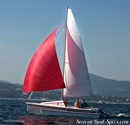Astus 20.1
Sailboat specifications
The Astus 20.1 is a 20’1” (6.13m) cruising trimaran designed by VDesign (France). She was built between 2004 and 2010 by Astus Boats (France).
Astus 20.1's main features
- Model
- Astus 20.1
- Hull type
- Trimaran
- Category
- Coastal cruising trimaran
- Sailboat builder
- Sailboat designer
- Country
- France
- Construction
- GRP (glass reinforced polyester):
- Hull: Single skin fiberglass polyester
- Deck: Single skin fiberglass polyester - Number of hulls built
- About 50
- First built hull
- 2004
- Last built hull
- 2010
- Appendages
- Centerboard : pivoting centerboard (main hull)
- Helm
- Single tiller
- Rudder
- Single transom hung rudder (main hull)
- Unsinkable
- No
- Trailerable
- Yes
- EC design categoryiThe CE design category indicates the ability to cope with certain weather conditions (the sailboat is designed for these conditions)
A: Wind < force 9, Waves < 10m
B: Wind < force 8, Waves < 8m
C: Wind < force 6, Waves < 4m
D: Wind < force 4, Waves < 0,5m - C
- Standard public price ex. VAT (indicative only)
- N/A €
Astus 20.1's main dimensions
- Hull length
- 20’ 1”6.13 m
- Waterline length
- 19’ 2”5.85 m
- Beam (width)
- 12’ 8”3.88 m
- Draft
- 3’ 7”1.1 m
- Draft when appendages up
- 1’0.3 m
- Folding type
- Sliding arms
- Overall width folded
- 8’ 4”2.53 m
- Light displacement (MLC)
- 827 lb375 kg
Astus 20.1's rig and sails
- Upwind sail area
- 242 ft²22.5 m²
- Downwind sail area
- 431 ft²40 m²
- Mainsail area
- 172 ft²16 m²
- Genoa area
- 70 ft²6.5 m²
- Asymmetric spinnaker area
- 258 ft²24 m²
- Gennaker area
- 215 ft²20 m²
- Rigging type
- Sloop Marconi fractional
- Mast configuration
- Deck stepped mast
- Rotating spars
- No
- Number of levels of spreaders
- 1
- Spreaders angle
- Swept-back (diamond)
- Spars construction
- Aluminum spars
- Standing rigging
- 1x19 strand wire continuous
Astus 20.1's performances
- Upwind sail area to displacementiThe ratio sail area to displacement is obtained by dividing the sail area by the boat's displaced volume to the power two-thirds.
The ratio sail area to displacement can be used to compare the relative sail plan of different sailboats no matter what their size.
Upwind: under 18 the ratio indicates a cruise oriented sailboat with limited performances especially in light wind, while over 25 it indicates a fast sailboat. - 466 ft²/T43.27 m²/T
- Downwind sail area to displacementiThe ratio sail area to displacement is obtained by dividing the sail area by the boat's displaced volume to the power two-thirds.
The ratio sail area to displacement can be used to compare the relative sail plan of different sailboats no matter what their size. - 828 ft²/T76.92 m²/T
- Displacement-length ratio (DLR)iThe Displacement Length Ratio (DLR) is a figure that points out the boat's weight compared to its waterline length. The DLR is obtained by dividing the boat's displacement in tons by the cube of one one-hundredth of the waterline length (in feet).
The DLR can be used to compare the relative mass of different sailboats no matter what their length:
a DLR less than 180 is indicative of a really light sailboat (race boat made for planning), while a DLR greater than 300 is indicative of a heavy cruising sailboat. - 53
Astus 20.1's auxiliary engine
- Engine(s)
- 1 outboard engine
- Engine(s) power
- 6 HP
- Fuel type
- Gas
Astus 20.1's accommodations and layout
- Cockpit
- Open aft cockpit
- Berth(s)
- 2
- Maximum headroom
- 4’ 7”1.4 m



Astus Boats Astus 20.1 sailing - - 2/4
Picture extracted from the commercial documentation © Astus Boats
Picture extracted from the commercial documentation © Astus Boats


Astus Boats Astus 20.1 sailing - - 3/4
Picture extracted from the commercial documentation © Astus Boats
Picture extracted from the commercial documentation © Astus Boats


Astus Boats Astus 20.1 detail - - 4/4
Picture extracted from the commercial documentation © Astus Boats
Picture extracted from the commercial documentation © Astus Boats
Similar sailboats that may interest you:
Sailboats
First built hull
Hull length
2013
23’ 10”7.25 m
2007
22’6.72 m
2015
19’ 8”6 m
2016
24’ 2”7.39 m
2015
24’ 7”7.5 m
2016
16’ 2”4.94 m
2018
19’ 6”5.95 m
2011
23’7 m
2006
24’ 2”7.39 m
2013
24’ 2”7.39 m
2008
21’ 10”6.65 m
1985
27’ 1”8.25 m
1991
24’ 2”7.38 m
1994
24’ 2”7.38 m
2014
24’ 4”7.4 m